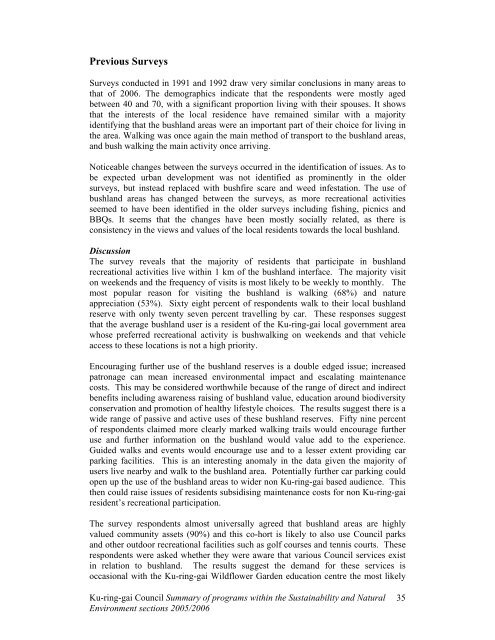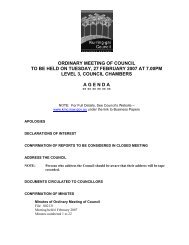ordinary meeting of council to be held on tuesday, 18 july 2006
ordinary meeting of council to be held on tuesday, 18 july 2006
ordinary meeting of council to be held on tuesday, 18 july 2006
You also want an ePaper? Increase the reach of your titles
YUMPU automatically turns print PDFs into web optimized ePapers that Google loves.
Previous Surveys<br />
Surveys c<strong>on</strong>ducted in 1991 and 1992 draw very similar c<strong>on</strong>clusi<strong>on</strong>s in many areas <str<strong>on</strong>g>to</str<strong>on</strong>g><br />
that <str<strong>on</strong>g>of</str<strong>on</strong>g> <strong>2006</strong>. The demographics indicate that the resp<strong>on</strong>dents were mostly aged<br />
<str<strong>on</strong>g>be</str<strong>on</strong>g>tween 40 and 70, with a significant proporti<strong>on</strong> living with their spouses. It shows<br />
that the interests <str<strong>on</strong>g>of</str<strong>on</strong>g> the local residence have remained similar with a majority<br />
identifying that the bushland areas were an important part <str<strong>on</strong>g>of</str<strong>on</strong>g> their choice for living in<br />
the area. Walking was <strong>on</strong>ce again the main method <str<strong>on</strong>g>of</str<strong>on</strong>g> transport <str<strong>on</strong>g>to</str<strong>on</strong>g> the bushland areas,<br />
and bush walking the main activity <strong>on</strong>ce arriving.<br />
Noticeable changes <str<strong>on</strong>g>be</str<strong>on</strong>g>tween the surveys occurred in the identificati<strong>on</strong> <str<strong>on</strong>g>of</str<strong>on</strong>g> issues. As <str<strong>on</strong>g>to</str<strong>on</strong>g><br />
<str<strong>on</strong>g>be</str<strong>on</strong>g> expected urban development was not identified as prominently in the older<br />
surveys, but instead replaced with bushfire scare and weed infestati<strong>on</strong>. The use <str<strong>on</strong>g>of</str<strong>on</strong>g><br />
bushland areas has changed <str<strong>on</strong>g>be</str<strong>on</strong>g>tween the surveys, as more recreati<strong>on</strong>al activities<br />
seemed <str<strong>on</strong>g>to</str<strong>on</strong>g> have <str<strong>on</strong>g>be</str<strong>on</strong>g>en identified in the older surveys including fishing, picnics and<br />
BBQs. It seems that the changes have <str<strong>on</strong>g>be</str<strong>on</strong>g>en mostly socially related, as there is<br />
c<strong>on</strong>sistency in the views and values <str<strong>on</strong>g>of</str<strong>on</strong>g> the local residents <str<strong>on</strong>g>to</str<strong>on</strong>g>wards the local bushland.<br />
Discussi<strong>on</strong><br />
The survey reveals that the majority <str<strong>on</strong>g>of</str<strong>on</strong>g> residents that participate in bushland<br />
recreati<strong>on</strong>al activities live within 1 km <str<strong>on</strong>g>of</str<strong>on</strong>g> the bushland interface. The majority visit<br />
<strong>on</strong> weekends and the frequency <str<strong>on</strong>g>of</str<strong>on</strong>g> visits is most likely <str<strong>on</strong>g>to</str<strong>on</strong>g> <str<strong>on</strong>g>be</str<strong>on</strong>g> weekly <str<strong>on</strong>g>to</str<strong>on</strong>g> m<strong>on</strong>thly. The<br />
most popular reas<strong>on</strong> for visiting the bushland is walking (68%) and nature<br />
appreciati<strong>on</strong> (53%). Sixty eight percent <str<strong>on</strong>g>of</str<strong>on</strong>g> resp<strong>on</strong>dents walk <str<strong>on</strong>g>to</str<strong>on</strong>g> their local bushland<br />
reserve with <strong>on</strong>ly twenty seven percent travelling by car. These resp<strong>on</strong>ses suggest<br />
that the average bushland user is a resident <str<strong>on</strong>g>of</str<strong>on</strong>g> the Ku-ring-gai local government area<br />
whose preferred recreati<strong>on</strong>al activity is bushwalking <strong>on</strong> weekends and that vehicle<br />
access <str<strong>on</strong>g>to</str<strong>on</strong>g> these locati<strong>on</strong>s is not a high priority.<br />
Encouraging further use <str<strong>on</strong>g>of</str<strong>on</strong>g> the bushland reserves is a double edged issue; increased<br />
patr<strong>on</strong>age can mean increased envir<strong>on</strong>mental impact and escalating maintenance<br />
costs. This may <str<strong>on</strong>g>be</str<strong>on</strong>g> c<strong>on</strong>sidered worthwhile <str<strong>on</strong>g>be</str<strong>on</strong>g>cause <str<strong>on</strong>g>of</str<strong>on</strong>g> the range <str<strong>on</strong>g>of</str<strong>on</strong>g> direct and indirect<br />
<str<strong>on</strong>g>be</str<strong>on</strong>g>nefits including awareness raising <str<strong>on</strong>g>of</str<strong>on</strong>g> bushland value, educati<strong>on</strong> around biodiversity<br />
c<strong>on</strong>servati<strong>on</strong> and promoti<strong>on</strong> <str<strong>on</strong>g>of</str<strong>on</strong>g> healthy lifestyle choices. The results suggest there is a<br />
wide range <str<strong>on</strong>g>of</str<strong>on</strong>g> passive and active uses <str<strong>on</strong>g>of</str<strong>on</strong>g> these bushland reserves. Fifty nine percent<br />
<str<strong>on</strong>g>of</str<strong>on</strong>g> resp<strong>on</strong>dents claimed more clearly marked walking trails would encourage further<br />
use and further informati<strong>on</strong> <strong>on</strong> the bushland would value add <str<strong>on</strong>g>to</str<strong>on</strong>g> the experience.<br />
Guided walks and events would encourage use and <str<strong>on</strong>g>to</str<strong>on</strong>g> a lesser extent providing car<br />
parking facilities. This is an interesting anomaly in the data given the majority <str<strong>on</strong>g>of</str<strong>on</strong>g><br />
users live nearby and walk <str<strong>on</strong>g>to</str<strong>on</strong>g> the bushland area. Potentially further car parking could<br />
open up the use <str<strong>on</strong>g>of</str<strong>on</strong>g> the bushland areas <str<strong>on</strong>g>to</str<strong>on</strong>g> wider n<strong>on</strong> Ku-ring-gai based audience. This<br />
then could raise issues <str<strong>on</strong>g>of</str<strong>on</strong>g> residents subsidising maintenance costs for n<strong>on</strong> Ku-ring-gai<br />
resident’s recreati<strong>on</strong>al participati<strong>on</strong>.<br />
The survey resp<strong>on</strong>dents almost universally agreed that bushland areas are highly<br />
valued community assets (90%) and this co-hort is likely <str<strong>on</strong>g>to</str<strong>on</strong>g> also use Council parks<br />
and other outdoor recreati<strong>on</strong>al facilities such as golf courses and tennis courts. These<br />
resp<strong>on</strong>dents were asked whether they were aware that various Council services exist<br />
in relati<strong>on</strong> <str<strong>on</strong>g>to</str<strong>on</strong>g> bushland. The results suggest the demand for these services is<br />
occasi<strong>on</strong>al with the Ku-ring-gai Wildflower Garden educati<strong>on</strong> centre the most likely<br />
Ku-ring-gai Council Summary <str<strong>on</strong>g>of</str<strong>on</strong>g> programs within the Sustainability and Natural<br />
Envir<strong>on</strong>ment secti<strong>on</strong>s 2005/<strong>2006</strong><br />
35
















